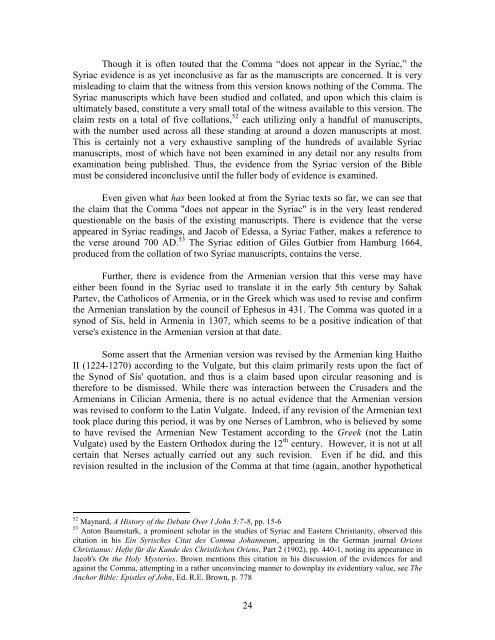A Defense of the Johannine Comma - Study to Answer.Net
A Defense of the Johannine Comma - Study to Answer.Net
A Defense of the Johannine Comma - Study to Answer.Net
Create successful ePaper yourself
Turn your PDF publications into a flip-book with our unique Google optimized e-Paper software.
Though it is <strong>of</strong>ten <strong>to</strong>uted that <strong>the</strong> <strong>Comma</strong> “does not appear in <strong>the</strong> Syriac,” <strong>the</strong><br />
Syriac evidence is as yet inconclusive as far as <strong>the</strong> manuscripts are concerned. It is very<br />
misleading <strong>to</strong> claim that <strong>the</strong> witness from this version knows nothing <strong>of</strong> <strong>the</strong> <strong>Comma</strong>. The<br />
Syriac manuscripts which have been studied and collated, and upon which this claim is<br />
ultimately based, constitute a very small <strong>to</strong>tal <strong>of</strong> <strong>the</strong> witness available <strong>to</strong> this version. The<br />
claim rests on a <strong>to</strong>tal <strong>of</strong> five collations, 52 each utilizing only a handful <strong>of</strong> manuscripts,<br />
with <strong>the</strong> number used across all <strong>the</strong>se standing at around a dozen manuscripts at most.<br />
This is certainly not a very exhaustive sampling <strong>of</strong> <strong>the</strong> hundreds <strong>of</strong> available Syriac<br />
manuscripts, most <strong>of</strong> which have not been examined in any detail nor any results from<br />
examination being published. Thus, <strong>the</strong> evidence from <strong>the</strong> Syriac version <strong>of</strong> <strong>the</strong> Bible<br />
must be considered inconclusive until <strong>the</strong> fuller body <strong>of</strong> evidence is examined.<br />
Even given what has been looked at from <strong>the</strong> Syriac texts so far, we can see that<br />
<strong>the</strong> claim that <strong>the</strong> <strong>Comma</strong> "does not appear in <strong>the</strong> Syriac" is in <strong>the</strong> very least rendered<br />
questionable on <strong>the</strong> basis <strong>of</strong> <strong>the</strong> existing manuscripts. There is evidence that <strong>the</strong> verse<br />
appeared in Syriac readings, and Jacob <strong>of</strong> Edessa, a Syriac Fa<strong>the</strong>r, makes a reference <strong>to</strong><br />
<strong>the</strong> verse around 700 AD. 53 The Syriac edition <strong>of</strong> Giles Gutbier from Hamburg 1664,<br />
produced from <strong>the</strong> collation <strong>of</strong> two Syriac manuscripts, contains <strong>the</strong> verse.<br />
Fur<strong>the</strong>r, <strong>the</strong>re is evidence from <strong>the</strong> Armenian version that this verse may have<br />
ei<strong>the</strong>r been found in <strong>the</strong> Syriac used <strong>to</strong> translate it in <strong>the</strong> early 5th century by Sahak<br />
Partev, <strong>the</strong> Catholicos <strong>of</strong> Armenia, or in <strong>the</strong> Greek which was used <strong>to</strong> revise and confirm<br />
<strong>the</strong> Armenian translation by <strong>the</strong> council <strong>of</strong> Ephesus in 431. The <strong>Comma</strong> was quoted in a<br />
synod <strong>of</strong> Sis, held in Armenia in 1307, which seems <strong>to</strong> be a positive indication <strong>of</strong> that<br />
verse's existence in <strong>the</strong> Armenian version at that date.<br />
Some assert that <strong>the</strong> Armenian version was revised by <strong>the</strong> Armenian king Haitho<br />
II (1224-1270) according <strong>to</strong> <strong>the</strong> Vulgate, but this claim primarily rests upon <strong>the</strong> fact <strong>of</strong><br />
<strong>the</strong> Synod <strong>of</strong> Sis' quotation, and thus is a claim based upon circular reasoning and is<br />
<strong>the</strong>refore <strong>to</strong> be dismissed. While <strong>the</strong>re was interaction between <strong>the</strong> Crusaders and <strong>the</strong><br />
Armenians in Cilician Armenia, <strong>the</strong>re is no actual evidence that <strong>the</strong> Armenian version<br />
was revised <strong>to</strong> conform <strong>to</strong> <strong>the</strong> Latin Vulgate. Indeed, if any revision <strong>of</strong> <strong>the</strong> Armenian text<br />
<strong>to</strong>ok place during this period, it was by one Nerses <strong>of</strong> Lambron, who is believed by some<br />
<strong>to</strong> have revised <strong>the</strong> Armenian New Testament according <strong>to</strong> <strong>the</strong> Greek (not <strong>the</strong> Latin<br />
Vulgate) used by <strong>the</strong> Eastern Orthodox during <strong>the</strong> 12 th century. However, it is not at all<br />
certain that Nerses actually carried out any such revision. Even if he did, and this<br />
revision resulted in <strong>the</strong> inclusion <strong>of</strong> <strong>the</strong> <strong>Comma</strong> at that time (again, ano<strong>the</strong>r hypo<strong>the</strong>tical<br />
52 Maynard, A His<strong>to</strong>ry <strong>of</strong> <strong>the</strong> Debate Over I John 5:7-8, pp. 15-6<br />
53 An<strong>to</strong>n Baumstark, a prominent scholar in <strong>the</strong> studies <strong>of</strong> Syriac and Eastern Christianity, observed this<br />
citation in his Ein Syrisches Citat des <strong>Comma</strong> Johanneum, appearing in <strong>the</strong> German journal Oriens<br />
Christianus: Hefte für die Kunde des Christlichen Oriens, Part 2 (1902), pp. 440-1, noting its appearance in<br />
Jacob's On <strong>the</strong> Holy Mysteries. Brown mentions this citation in his discussion <strong>of</strong> <strong>the</strong> evidences for and<br />
against <strong>the</strong> <strong>Comma</strong>, attempting in a ra<strong>the</strong>r unconvincing manner <strong>to</strong> downplay its evidentiary value, see The<br />
Anchor Bible: Epistles <strong>of</strong> John, Ed. R.E. Brown, p. 778<br />
24


